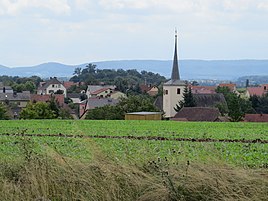Sound field (Lülsfeld)
|
Sound field
community Lülsfeld
Coordinates: 49 ° 52 ′ 25 ″ N , 10 ° 21 ′ 28 ″ E
|
|
|---|---|
| Height : | 254 m |
| Residents : | 379 (1987) |
| Incorporation : | May 1, 1978 |
| Incorporated into: | Lülsfeld |
| Postal code : | 97511 |
| Area code : | 09382 |
Schallfeld is a district of the municipality of Lülsfeld in the Lower Franconian district of Schweinfurt .
Geographical location
The Kirchdorf Schallfeld is located in the east of the Lülsfeld municipality. Further north is the former district town of Gerolzhofen , while the area of the municipality of Oberschwarzach begins in the east . The districts of Düttingsfeld and Wiebelsberg are closest to Schallfeld. In the south is the Aumühle , further south is Brünnau , a district of Prichsenstadt in the Kitzingen district. Lülsfeld itself is in the west. Frankenwinheim is in the northwest. Schallfeld is on federal highway 286 .
In terms of nature, Schallfeld and its area are part of the so-called Steigerwald foreland of Neuses . Characteristic for this part of the Iphofen-Gerolzhofener Steigerwaldvorland is the hilly appearance with the narrow river valleys and small streams.
history
Schallfeld was first mentioned in 1260. The name in the document was "Schalkevelt" and refers to the unfree and servants as the "Schalke field". They settled on the edge of the landlord's corridor Gerolzhofen. The place reappeared eight years after it was first mentioned. Count Hermann I zu Castell sold his goods to the Cistercian monastery in Ebrach on March 26, 1268 . Until 1313 the ministerial family of the Lords of Schalkvelt were also wealthy in the village.
During the Middle Ages , the district of Schallfeld was severely split up as a manorial estate. A total of 22 landlords were resident there. Messrs Rösch from Gerolzhofen had a significant share in the goods in the village, and they also owned a so-called Freihof in the village. By the 17th century, the Würzburg monastery and the Ebrach monastery almost came into the possession of the entire village. Only the Fuchs von Bimbach and the Echter von Mespelbrunn remained involved in the rule.
In 1525, the Schallfeld farmers revolted against the landlords in the German Peasants' War . They burned down the Freihof, but were soon beaten back by the troops of the Prince-Bishop of Würzburg. The Schallfelder Schultheiss then had to sign a debt certificate. As early as 1554, the village suffered further destruction in the Second Margrave War . The damage totaled 994 guilders .
In the course of the Counter Reformation , the witch hunt began in the diocese of Würzburg. In particular, the nearby Gerolzhofen developed into the center of the "witch burners". The “Schmiedskuni” from Schallfeld was the first to die at the stake in the city. The village was captured and burned down a total of ten times during the Thirty Years' War . Between 1631 and 1648, both the Catholic imperial and Protestant Swedes plundered.
The Seven Years War brought further destruction when Schallfeld was pillaged three times by Prussian troops. In 1796 the French began to rage in the village and dragged away the village treasury. A total of 13 sound fields died in the First World War , with 26 citizens there were many more villagers to complain about in the Second World War . Schallfeld has been part of the municipality of Lülsfeld in the Schweinfurt district since 1978.
Culture and sights
Architectural monuments
The center of the place is the Catholic parish church. It is dedicated to St. Aegidius . The church was first mentioned at this point in the 11th century. Even today there are Romanesque remains in the basement of the building. In 1682 the church was given a Julius Echter tower , and the nave was rebuilt between 1715 and 1726. The coat of arms above the south portal is that of the Würzburg prince-bishop Johann Philipp von Greiffenclau.
The large altars date from the time the nave was built. The crucifixion of Christ is depicted on the sheet of the high altar , flanked by four figures of saints. Another depiction of the crucifixion is on one of the side altars, the second shows the crowning of thorns. The most valuable element of the interior is a figure of Our Lady from 1515. The baptismal font came into the church in 1600.
In addition, several wayside shrines and small memorials have been preserved in the village. All tortures come from the 18th century and are testimony to popular piety during this time. A typical Franconian courtyard gate has also been preserved in Schallfeld. A large stone crucifixion group in front of the church dates from 1853 . Two buildings that are still inhabited are classified as historical monuments: a farmhouse from 1922 and a hipped roof house from the 18th century.
legend
A Schallfelder farmer came back one evening from Lülsfeld across the fields to his home village. At the side of the road he discovered a goose that apparently didn't belong to anyone. The farmer took advantage of the situation, hid the goose in his rucksack and locked it in his stall that night . When he went to check on his animals the next morning, the goose had disappeared. Instead, there was a strange woman in the farmer's stable.
literature
- Karl Treutwein : From Abtswind to Zeilitzheim. History, sights, traditions . Volkach 4 1987.
Web links
- Sound field in the location database of the Bavarian State Library Online . Bavarian State Library
